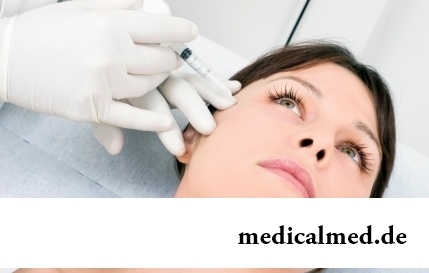





Prenatal diagnosis
 Prenatal diagnosis represents a complex of prenatal inspection. The main objective, at the same time, puts identification at a stage of pre-natal development of the child of various pathologies.
Prenatal diagnosis represents a complex of prenatal inspection. The main objective, at the same time, puts identification at a stage of pre-natal development of the child of various pathologies.
What prenatal diagnosis is applied to
Thanks to prenatal diagnosis of hereditary diseases, it is possible to find the following disturbances in a fruit:
- Down syndrome;
- Edwards's syndrome;
- Disturbances in development of heart, etc.
Prenatal diagnosis of hereditary diseases plays a crucial role in destiny of future child. On the basis of the obtained data, parents, together with the doctor, make the decision on that, pregnancy will be interrupted or not. At the favorable forecast of doctors, rehabilitation of future child can be carried out.
Prenatal diagnosis also is also definition of paternity according to the genetic expertize which is carried out on early durations of gestation and sex determination of the child.
Main methods of prenatal diagnosis
 In modern conditions, in prenatal diagnosis various technologies are applied. Reliability degree, opportunity levels at them various.
In modern conditions, in prenatal diagnosis various technologies are applied. Reliability degree, opportunity levels at them various.
There are two main groups of prenatal diagnosis:
1. Noninvasive;
2. Invasive.
Noninvasive methods, or still them call low-invasive, do not provide surgical intervention and traumatizing mother and a fruit. Such procedures are harmless, and can recommend them to all pregnant women, without exception.
Invasive prenatal diagnosis assumes surgical intervention (invasion) into the woman's organism (a cavity of her uterus).
Invasive prenatal diagnosis is unsafe for mother and a fruit therefore it is appointed by doctors only in extreme cases when there are serious fears for health of future child.
The pregnant woman needs to visit planned ultrasonography surely, it will allow to exclude or, on the contrary, to confirm need for carrying out invasive prenatal diagnosis.
The procedures relating to noninvasive prenatal diagnosis
The following belongs to methods of noninvasive prenatal diagnosis:
- Ultrasonic prenatal screening (observation in dynamics of fetation);
- Prenatal screening of serum factors of blood of mother.
Prenatal screening – no other than the usual ultrasonography shown to all pregnant women. The obligatory periods of passing of ultrasonography are the following durations of gestation:
1. 11 – 13 weeks;
2. 22 – 25 weeks.
Prenatal screening provides diagnosis of a condition of a fruit and mother's organism. The sensor (transdyuser) is installed on the surface of a stomach of the woman, it lets out sound waves. These waves are also caught by the sensor, transferring them to the monitor screen. On early durations of gestation other kind of prenatal screening of ultrasonography can be used. It is a transvaginal way at which the sensor is entered into a vagina of the pregnant woman.
Prenatal screening gives the chance to define on different durations of gestation a number of deviations in fetation:
1. Inborn heart diseases, kidneys, liver, intestines, extremities, etc.;
2. Symptoms of a Down syndrome - to 12 week durations of gestation.
Besides, prenatal screening of ultrasonography defines development of the pregnancy:
- Uterine or extrauterine;
- Quantity of fruits in a uterus;
- Age of a fruit (duration of gestation);
- Provision of a fruit (pelvic or head presentation);
- Lag in fetation;
- Heartbeat (its character);
- Sex of the child;
- State and arrangement of a placenta;
- Assessment of amniotic waters;
- Condition of a blood-groove in placenta vessels;
- Uterus tone.
Thus, prenatal screening helps to find out whether normally there takes place pregnancy. For example, having defined a condition of a tone of uterine muscles, it is possible to establish threat of abortion (abortion) and to take urgent measures for elimination of this problem.
Prenatal screening of maternal serum factors assumes a blood analysis, the pregnant woman taken from a vein. The best term for the analysis is the period from the 15th to the 20th week of pregnancy.
Blood serum of the woman is investigated according to contents in it certain substances:
- Alpha-fetoprotein (AFP);
- Not the Conjugated Estriol (CE);
- Chorionic Gonadotrophin (CG).
Such way of prenatal screening possesses a fine precision. But, in certain cases, tests can give false positive or false-negative answers. Then appoint additional procedures for prenatal diagnosis of hereditary diseases. It can be prenatal screening (ultrasonography) or kinds of invasive prenatal diagnosis.
The procedures relating to invasive prenatal diagnosis
For prenatal diagnosis of hereditary diseases and other disturbances in fetation, in case of the decision on use of invasive methods of prenatal diagnosis, such procedures are used:
- Kordotsentez (capture of test and research of umbilical blood);
- Chorion biopsy (studying of structure of cells which are a basis for formation of a placenta);
- Amniocentesis (capture and research of amniotic waters of mother);
- Platsentotsentez (identification of negative effects of the infection transferred to the pregnancy period).
Advantages of invasive prenatal diagnosis are 100% a guarantee of result and its speed. Besides, invasive prenatal diagnosis can be used on the earliest durations of gestation.
Thus, if there is a suspicion on any deviation of development of pregnancy and health of the child, thanks to a way of prenatal diagnosis of hereditary diseases, it is possible to draw exact conclusions. Therefore, doctors and parents are given a real opportunity to make the specific decision in further actions:
1. To leave the child;
2. To make abortion.
At the decision of parents, despite pathology, to leave pregnancy, thanks to early prenatal diagnosis of hereditary diseases, at the disposal of doctors there is time for the greatest possible correction of pregnancy and treatment of a fruit in a womb.
If it is about abortion, this procedure is morally and physically postponed easier on the early term on which deviations in development were revealed.
The American scientists made experiments on mice and came to a conclusion that water-melon juice prevents development of atherosclerosis of vessels. One group of mice drank usual water, and the second – water-melon juice. As a result vessels of the second group were free from cholesteric plaques.

The Genetically Modified Organisms (GMO) are plants or animals (as a rule, agricultural) in whose genotype...
Section: Articles about health
The phenomenon of improvement of a condition of the patients at administration of drugs who are not containing active agents, so-called effect of placebo is known long ago. At the end of the 18th century the American doctor Perkins began to treat people the "miracle" sticks made of a spl...
Section: Articles about health
The advantage of swimming for the person is so high that this sport is not only the most popular, but also is widely applied in medicine and rehabilitation processes. If you look for for yourself the occupation allowing pleasantly and to spend time, then swimming with advantage – the fact that it is necessary for you. And give learns several facts about swimming....
Section: Slideshow
Any of us is not insured from a heavy illness of the loved one. Happens and so that someone from family members becomes lying бо...
Section: Articles about health
All know that self-treatment is dangerous. However absolutely it is almost impossible to do without it. Rate of modern life does not allow to handle each small trouble to the doctor and information on ways of independent rendering medical the help...
Section: Articles about health
Climax - process of fading of reproductive function of an organism in process of its aging. At women the main sign of its approach is the termination of a menstrual cycle. Officially the menopause is diagnosed when periods are not observed within 12 months. Age changes quite often are followed by emotional failures, disturbance of thermal control and sweating, dizzinesses and headaches, tachycardia and other unpleasant phenomena. This complex of symptoms...
Section: Articles about health
Scientists always aimed to offer fundamental explanations for medical problems. Their theories formed the basis of modern methods is treated...
Section: Articles about health
Dogrose – one of the most widespread adornment and medicinal plants growing practically in all territory of our country. To most of Russians it is a beautiful bush it is known, first of all, as a source of fruits, extremely vitamin-rich....
Section: Articles about health
Bulimia and anorexia, are heavy deviations of a feeding behavior, become a cause of death of patients much more often than all other nervous breakdowns combined. In 60% of cases two illnesses accompany each other: patients feel horror before danger of set of excess weight and try to refuse as often as possible food, but periodically suffer from attacks of sudden hunger and an uncontrollable overeating. Each patient with anorexia and bulimia needs the help qualified пс...
Section: Articles about health
Separate food - the system of meal based on digestion physiology which is carried to improvement methods. In opinion д...
Section: Articles about health
Stability of a hormonal background is one of the most important conditions of preservation of health of the woman. At the same time endocrine system – the thin device extremely sensitive to any external influences. Changes of an image жиз can become the reason of hormonal failure...
Section: Articles about health
So, you resolved to lose weight. And now you try to understand what to begin with: from exercise stresses or a diet? And how to make that process of weight loss did not give you an inconvenience, and, on the contrary, brought joy?...
Section: Slideshow
One of the major chemical processes happening in a human body are oxidation reactions. They go with participation of fats...
Section: Articles about health
Diseases of joints often begin imperceptibly for the person. The first stages of destruction of the cartilaginous tissue providing soft and free sliding of heads of bones in joint bags proceed slowly and absolutely without serious consequences. Especially unpleasantly for that this пр...
Section: Articles about health
All of us, unfortunately, should face flu nearly an every year. It would seem, so frequent disease has to be studied already up and down, and each person, at least once to them had (and the number of such people in our country aims at 100%), has to know the basic rules of its treatment. However as shows experience of doctors, there is no it, and often people, self-confidently thinking what is known as it is necessary to be treated, make mistakes....
Section: Articles about health
80% of women at least once to lives complained of discomfortable feelings to breasts, consolidations and nagrubaniye. These are mastopathy symptoms. Mas...
Section: Articles about health
Obesity is called a disease of 21 centuries, for the last 100 years the number of the people suffering from excess body weight considerably increased. Statistically, on Earth already about 1,5 billion corpulent people, and 500 million from them have extreme degree of completeness, are negative...
Section: Articles about health
One of the useful properties presented to the person by the nature is ability to feel fear. This ability is designed to signal about approach of a dangerous situation and to help to avoid in advance it to keep life. However if the fear is persuasive and is not reasonable, it can seriously limit possibilities of the person in respect of socialization and self-realization. Such pathological fear is called a phobia....
Section: Articles about health
Statistically cystitis 25-30% of women up to 40 years have. With age this indicator raises, besides many do not get in to become...
Section: Articles about health
You heard that laughter prolongs life? Researchers did not manage to establish longevity direct link with sincere fun yet, but several facts confirming beneficial influence of risibility on the state of health are clinically proved....
Section: Articles about health
A little more than a century ago goat milk was a traditional food stuff of most of Russians. Unfortunately, today on tables of our compatriots it appears extremely seldom. The reason that the use of so useful product practically came to naught, not only in very modest volumes of its production and, respectively, rather high cost. Potential consumers are just insufficiently informed on unique properties of goat milk and that advantage which...
Section: Articles about health
Smoking not only exerts a negative impact on the state of health of the consumer of tobacco products, but is a source з...
Section: Articles about health
Contrary to popular belief, the multiple sclerosis (MS) is not connected neither with sclerous changes of walls of vessels, nor with age forgetfulness and problems with concentration of attention. This disease has the autoimmune nature. Pathological process of a vyrazh...
Section: Articles about health
Eyes – one of the most vulnerable areas on a face therefore age changes concern them first of all. Whether it is possible to keep look youth for many years and what procedures are offered for achievement of this purpose by cosmetologists? And maybe, the only option of rejuvenation is surgery – a blepharoplasty? Let's try to understand this question....
Section: Articles about health
Maternal milk is the best food for the newborn. It is the unique natural product containing optimum set...
Section: Articles about health
To look healthy and means well-groomed not only to be pleasant to people around, but also to feel strong, sure and taken place. Specialists in the field of cosmetology quite often note that whether not all women are able to look after skin...
Section: Articles about health
Urogenital candidiasis (milkwoman) – a fungal infection which annoys unpleasant feelings in the field of generative organs, being followed by white curdled allocations, an itch, discomfort during an urination, pain. She is called by Candida fungus – the opportunistic organism living on mucous membranes of an organism....
Section: Articles about health
